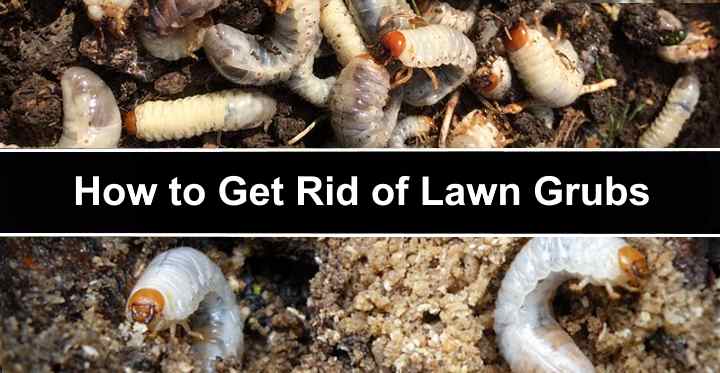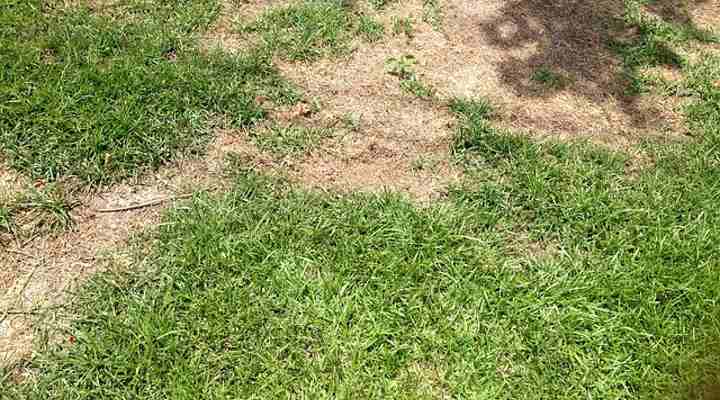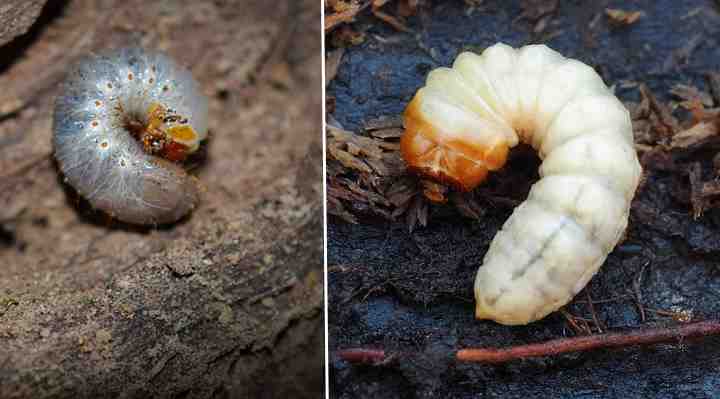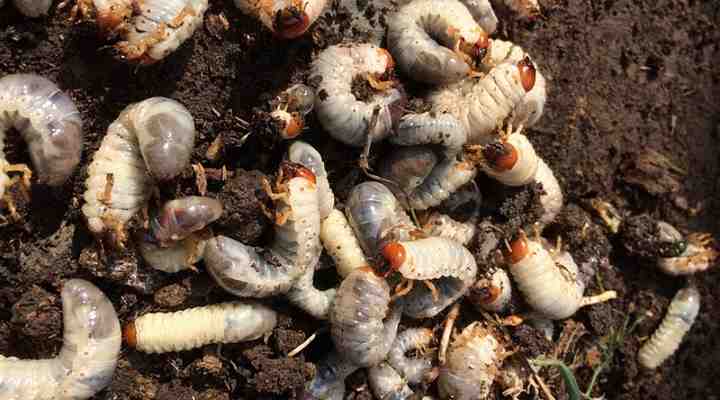Grubs In Lawn: How to Get Rid of Grubs in the Garden (With Pictures)

Grubs in the lawn can go undetected until you notice patches of bare turfgrass in your lush, green lawn. Plump, white, hungry grubs live in the soil and gorge on grass and plant roots. Getting rid of white grubs in the garden is essential to keep lawn grass healthy and green. Thankfully, with the proper care, it’s possible to stop grubs from causing havoc in your garden.
Getting rid of white lawn grubs involves knowing how to identify them, where to look for them, and how to eradicate them. Of course, to get rid of turf grubs in the soil for good also means preventing them from returning.
This article is a guide to getting rid of lawn grubs using natural, non-toxic grub worm killers. You’ll find out how to find the soft, white worm-like creatures and disturb their lifecycle.
What are Lawn Grubs?

Lawn grubs look like a small white worms but they are not true worms but the larvae of beetles
Also called worm grubs, lawn grubs are the larvae of various beetles. You can identify a lawn grub by its creamy-white, plump oval body and bronze-orange head. Lawn grubs measure about 0.5” (1.2 cm) long and curl up in a C-shape. The wriggling grubs feed on grass roots.
You usually find the grubs living in turfgrass. This is one reason why they are also called grass worms, turf grubs, and lawn grubs. Although the garden grubs are sometimes called worms, they are not true worms.
What Do Grubs Turn Into?

The larvae of scarab beetles such as the Japanese beetle (left) and June beetles (right) cause the most damage
White lawn grubs turn into beetles. Generally, the larvae from three types of beetles in the family Scarabaeidae (scarab beetles) are the grubs that cause the most damage to lawns. These are the Japanese beetle (Popillia japonica), June beetles (Phyllophaga), and the European chafer (Amphimallon majale). Scarab beetles can also damage plants, but the grubs cause the most damage to lawns.
After the white subterranean grubs become beetles, they emerge from the soil to continue their lifecycle. The scarab beetles scurry around gardens, eating plant leaves, flowers, and fruits.
Lawn Grub Life Cycle
The life cycle of lawn grubs is one to three years, depending on the species. Larvae hatch from beetle eggs in mid to late summer. The hungry grubs munch through turfgrass roots and then bury deeper into the ground over winter. In spring, the white grubs resume feeding on roots before becoming pupae and emerging as adult beetles.
Lawn grubs have a long lifecycle. Because they spend most of their life in the soil, they are difficult to detect. You may only see signs of grass worm activity if there is a large number of the lawn ‘bugs.’ So, knowing the lawn grub life cycle is key to killing the grubs in the soil before they do any damage.
What Do Grubs Eat?
Lawn grubs eat almost anything in the soil. The hungry beetle larvae in lawns eat grass roots, destroying the look of your turfgrass. In soil, beetle grubs chew through any type of plant’s roots. The grub worms also quickly destroy seedlings and young plants by eating their roots.
Grub Worm Damage
Beetle grubs can do damage to vegetables, fruits, and shrubs if they live in garden soil. As they gorge on shrub, vegetable, and flower roots, they destroy the plant’s nutrient source. You may notice that grub damage stunts the growth of smaller plants or even kills them. Large grub populations also cause larger, mature plants to wilt and even die.
White garden grubs also cause secondary damage. A grub infestation attracts birds and animals that can ruin your garden. For example, raccoons, skunks, and a flock of birds can dig up the soil around your plants looking for some ‘grubs.’ Not only does this animal activity spoil your garden’s appearance, but the pests can also damage plants and crops.
How to Tell If You Have Lawn Grubs (Sign of Grub Damage)

Grub damage to lawn looks like irregular patches of dead grass or bare soil
The most common way to know if you have lawn grubs is by bare patches of soil appearing on your lawn. But the best way to tell if you’ve got a grub problem is to dig up a patch of lawn to see if C-shaped worm-like white bugs are wriggling in the soil.
Signs of grub damage in lawns usually happen if there are more than ten grubs per square foot (0.1 m²). Even if you have between six and nine grass grubs per square foot (0.1 m²), you may see damage from animals digging to look for grubs.
Bare patches on lawns are the most common sign of a grub infestation. As the grubs eat turfgrass roots, the grass above the soil’s surface dies and doesn’t grow back. Some gardeners think that these dead grass patches are due to fertilization issues and add more lawn fertilizer. However, excessive amounts of fertilizers can make the grub problem worse.
A study checked the effects of nitrogen fertilizer (NF) on soil nematode community and found that the NF treatment resulted in a significant decrease of predatory nematodes. Beneficial nematodes are tiny parasitic worms that kill the lawn-destroying grubs.
Patches of lawn that feel spongy to walk on could also indicate grubs in the garden. Because grubs destroy lawn grass roots, the soil of infested lawn patches loses its firmness. You’ll also notice that the lawn peels away easily if grubs have destroyed its roots.
Noticing increased animal activity on a patchy lawn could also mean you’ve got grubs in the soil. Moles, skunks, raccoons, and other four-legged pests tear up lawns to find food. Of course, the critters could be after worms or beneficial grubs. So, it’s best to confirm if you’ve got a problem with scarab beetle larvae before treating them.
How to Prevent Grubs

Grub prevention can be done with soil tilling, natural lawn fertilizer and mowing grass less often
Lawn grub prevention is crucial to prevent these insects from becoming a nuisance. Here are some ways to stop white grubs from multiplying and damaging lawns and gardens.
Let Grass Grow Longer for Grub Prevention
Mowing your grass less often helps prevent scarab beetles from laying their eggs in grass soil. Ideally, keep grass 3” or 4” (7.6 – 10 cm) long to avoid getting beetle eggs in the ground. The darker environment near the soil level seems inhospitable for beetles—so they’ll look elsewhere to lay their eggs.
Use Natural Lawn Fertilizer to Prevent Grubs
Healthy lawns are less prone to white grub infestations. So, it would be best to use natural lawn fertilizer to keep your lawn lush and green. As mentioned previously, excessive chemical fertilizers with high nitrogen content decrease beneficial nematodes that kill white grubs, making any issues with lawn grubs get worse.
A healthy lawn can support up to five white grubs per square foot (0.1 m²) without signs of grub damage.
Related reading: How to maintain an organic lawn.
Till the Soil to Prevent Grubs in the Garden
One way to prevent grubs from destroying your shrubs or crops is to till the ground in the fall. It’s a good idea to get rid of old plants. Then till the soil to about 6” or 7” (15 – 18 cm) deep. Then two weeks later, till the top surface to the ground. Handpick any white grubs and drop them into soapy water to kill them.
When to Apply Grub Worm Treatment
The best time to treat lawn grubs is in late summer or early fall. During this time, the grubs have recently hatched, are relatively small, and are nearer the soil’s surface. If you wait until spring to treat grubs in the ground, they are usually much larger and more challenging to kill.
How to Get Rid of Grubs (Natural Grub Killers)

Grub damage to lawn and plants is best treated with natural grub control methods
The best way to get rid of grubs is to use natural grub treatments. Grub killers such as beneficial nematodes, neem oil, and milky spore help eradicate grubs in the soil. What’s more, these natural grub control methods don’t interfere with your garden’s biodiversity or ecosystem.
Eliminating white grubs in your lawn naturally is best done using an integrated pest management (IPM) approach. IPM involves using several grub control methods to prevent beetles from laying eggs and killing grubs when they hatch.
Of course, you can use chemicals to eliminate grubs. Although pesticides and insecticides can kill grub worms fast, they can also interfere with other beneficial insects. Additionally, many people have concerns about putting potentially toxic chemicals on lawns where children and pets play.
Even if you find a few grubs in your lawn, you may not need to kill them. Healthy lawns can generally support up to five white grubs per square foot (0.1 m²). If there are fewer than five, you could let them be.
Let’s look in detail at three natural ways to get rid of lawn grubs if they are spoiling your lush, green turfgrass.
Beneficial Nematodes Kill Grubs in Lawns
Spraying beneficial nematodes on grass can eliminate beetle grubs from lawns naturally. Nematodes are tiny parasitic worms that invade the bodies of white grubs. They then release bacteria that infect and kill the grass-destroying grubs. Using nematodes for grub control doesn’t affect other animals, beneficial insects, or earthworms.
Scientific evidence suggests that spraying lawns with beneficial nematodes can effectively reduce grub numbers. One study found that treating the ground with Steinernema carpocapsae and Heterorhabditis indica killed up to 80 percent of scarab grub populations.
To use nematodes as a white grub killer, it’s crucial to follow the manufacturer’s instructions. Nematodes are living organisms, and you should use them as soon as possible after buying them.
Mix the powdery solution in water and then apply it to your lawn with a watering can or hose-end applicator. It’s best to treat lawns with nematodes when the soil is at least 50°F (10°C), and you don’t expect rain. Apply the nematodes in the fall and late spring.
Kill Lawn Grubs with Milky Spore Powder/Granules
Milky spore is an environmentally friendly way to kill lawn grubs without harming other insects. Milky spore is a bacterial disease that infects white grubs as they munch on turfgrass roots. This biological grub control ends up killing scarab beetle larvae, preventing them from doing more damage to your lawn.
One of the benefits of milky spore is that it stays in the soil for a long time, killing any grubs that happen to live there.
Milky spore (Bacillus popilliae) was used extensively in the 1940s to kill Japanese beetle larvae. A study found that still 30 years later, soil treated with milky spore disease had fewer grubs than untreated areas. Also, the bacterial disease only targets Japanese beetle grubs, so it doesn’t kill earthworms.
Milky spore is easy to apply to lawns to keep them free from grass grubs. Put a teaspoon of milky spore powder 3 to 4 ft. (1 m) apart on the lawn in a grid shape. Use a gentle spray of water from a hose to water in the powder. Water for 15 minutes.
You only need one application to keep kill grubs and stop them from damaging your lawn.
Use Neem Oil to Eradicate Grubs from Lawns
Neem oil is a natural pesticide that stops lawn grubs from feeding and eventually kills them. A neem oil solution also prevents eggs from hatching and hinders larvae development. You can also use neem oil on foliage to stop Japanese beetles from destroying leaves.
A field study into the effectiveness of neem oil found it useful as a natural grub killer. Sprays containing neem oil were applied to turfgrass. The researchers found that the natural insecticide Azadriachtin in neem oil causes molting disorders and Japanese beetle larvae death in their early instars.
To use neem oil as a biological control for white lawn grubs, apply the solution in late summer or early fall while the grubs are immature.
To treat lawns for beetle grubs, mix 2 tablespoons of neem oil for every gallon (4.5 l) of water. Use a watering can or hose spray applicator to water your lawn thoroughly. Ensure you cover the entire lawn to kill off all grubs. Use every seven days until you no longer have signs of lawn grubs.
How to Treat Grub Damage
After treating your lawn for grub damage, it’s vital to restore your turfgrass to its former lush, green appearance. For best results, repair grub damage in the fall or early spring. Treating grub damage at this time gives the lawn a better chance of growing and becoming healthy again.
To treat grub damage, the first step is to rake off dead grass and remove thatch. Next, use a lawn aerator to perforate the lawn with small holes. This action allows nutrients to get to the roots, prevents compaction, and results in a healthy lawn. Then, reseed the bare patches of lawn with grass seed.
After you have reseeded the lawn to repair grub damage, thoroughly water the grass.
Proper lawn grub prevention, natural lawn fertilization, and proper mowing will keep your turfgrass in excellent health—free from white grubs.
Related articles:
